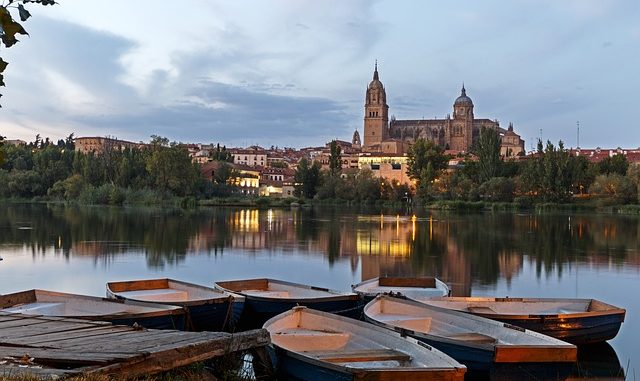
The city of Salamanca is one of the great places to enjoy the cuisine of the region of Castlla-León. Salamanca is a World Heritage City with the 3rd oldest university in Europe. That makes it one of the finest examples of a medieval academic and ecclesiastic institutions in Western Europe. The university began life in 1134 and only Bologna and Oxford are older. Anyone visiting the city will know it as the ‘Golden City’ because of the honey coloured sandstone used in its ancient buildings.
What must be attractive is the high student population which automatically makes the city a wonderful hub-bub of youthful life and vibrancy.
What however attracts me to the region is the cuisine. There is much to admire although it will certainly appeal to the carnivores amongst us. When we were assessing the various dishes of the region a few notable types appeared. It is common to see dishes described as salmantina which means they are from the city.
Hornazo
The classic Spanish meat pie which is not only eaten in Salamanca but also another famous city called Avila. It comes across as an advanced pork pie being prepared with pork loin, chorizo and hard-boiled eggs. A boiled egg is often found in a pork pie and lends a little variety to the overall meatiness from the pork. What really peps it all up is spicy chorizo which we know as a classic blood sausage. That sausage is sautéed in bacon fat to give it added flavour and mouthfeel. You could call it a chorizo and egg pie !
The pie has a seasonal element to it. It was originally made for eating in the countryside on the Monday after Easter which is known as the Lunes de Aguas festival. It explains the egg ingredient in many senses. The name comes from the unusual tradition of the prostitutes of the town who wore a petticoat called an enagua. During Lent the men of the town were not to be distracted and these ladies were sent to the other side of the Tormes river. In celebration of their return on Easter Monday, a large party on the river banks involved eating this hornazo.
Whilst there are other versions around Spain most come covered in pie pastry and there are stuffed bread-loaf versions too. That bread version is always white rather than wholemeal and is rectangular. A lattice design is essential and must be baked to a golden colour.
Other local specialties include cochinillo al fuego (roasted suckling pig), farinato (white sausage) and chanfaina salmantina (a stew made from trotters, rice, sweetbreads and chorizo).
Farinato (Farinate)
Farinato is a white meatless sausage which comes from various Spanish provinces but is very typical and eaten widely in Salamanca. It is prepared from lard or butter, bread to act as a crumb, flour, pepper and especially paprika as found in chorizo, onion and garlic and salt. What gives it special kick is the aniseed and brandy which add a particular flavour. It can also contain cumin.
We could say it is the hispanic version of a Glamorgan sausage although that is entirely unique. There is a similar Portuguese sausage known as Farinheira because “farinha” means flour in Portugal. The sausage was probably one eaten by the poor which is often the situation where meat-free sausages were consumed.
Chanfaina Salmantina
A classic traditional dish of the region. The chanfaina is a stew of lamb but combined with rice that could also be paella in texture. This dish too was eaten to celebrate the slaughter of food animals and a hard harvest. It is thus a common dish of Autumn and early Winter. The stew is flavoured with cumin and paprika, bay, plenty of onion and garlic and of course some boiled eggs.


I really like your writing and I took this piece with me on holiday. I was in Avila but I traveled to Salamanca just to see what all the fuss was about. What a great city and and yes it is full of wonderful food. I love ham and it met all my expectations.